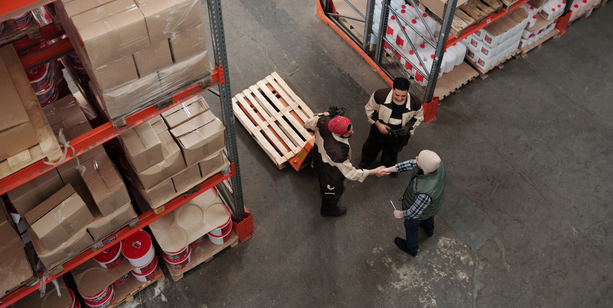A warehouse is a storage facility where permanent, often automated, storage and tracking of inventory is provided. A warehouse normally provides storage for goods or materials until they can be sold to customers at a discount or place orders with suppliers. Warehouses can be found in many forms and sizes. They are usually connected to other functions within an organization such as sales, production and distribution so that inventory can flow efficiently. They are also part of a company’s logistics network as they support the movement of goods from manufacturer to store shelves to after-sales service outlets. Warehousing refers to the process of storing items until they are sold or ordered by another party. This process involves providing secure storage during which time items may not be accessed by anyone except authorized personnel such as maintenance workers or repair technicians.

What is a warehouse for?
A warehouse is a facility where goods are stored until they can be sold or shipped to customers. A warehouse is commonly called a “warehouse” or “ware house”. Goods are often stored and transported in bulk quantities, which is why warehouse facilities are often called “warehouses” as well. A warehouse can handle both inbound and outbound shipments, so it is not just for receiving products and storing them. Companies use warehouses for a variety of reasons, such as:
– Maintaining an inventory of the goods that have been sold.
– Keeping an inventory of the goods that are on hand for sale.
– Proactively ordering materials and receiving them from suppliers.
– Selling items to customers in bulk quantities.
Why use warehousing?
The benefits of choosing a warehousing solution include:
– Compliance with regulations regarding temperature, humidity, and other environmental conditions.
– Automation of storage, retrieval, and transportation of inventory.
– Protection from theft by personnel.
– Security of keys and equipment.
– Decentralized storage that allows for tighter geographical concentration of inventory.
– Distribution of items to shelves and outlets.
– Management of inventory levels.
– Provision of reporting for inventory levels and sales.
– Access to inventory information via electronic data exchange systems.
Types of Warehouse Solutions
A range of different warehouse types exist, each suitable for different types of organizations.
– High-bay: A large warehouse where the buildings are built at ground level to create rows of high-bay columns that can house vehicles and large storage equipment.
– Low-bay: Low-bay warehouses are built at ground level, too, but instead of rows of high-bay columns, low-bay warehouses are laid out in T-shaped lots.
– Modular: Many industries’ needs evolve as they grow. As organizations expand, they often reach a point where they need to change their warehouse model. New buildings are placed on the site, creating space for a different kind of facility. Modular buildings are designed for rapid reconfiguration to meet changing business needs.
– Remote operation: Operators in a remote warehouse can use an interactive system to view and manage their equipment and inventory from a central location.
– Separate lots: In some industries, it’s essential to have a controlled environment, with controlled temperature and humidity, that is free from dust and other airborne particles.
– Ship-to: Ship-to warehouses have a dock or access point near the site where materials are picked up and delivered to manufacturing or distribution operations.
Warehouse Size and Capacity
The size of a warehouse will depend on a number of factors, including the type of products that will be stored, their perishability and the volume of sales that a company expects to make. For example, a pharmaceutical company stores a large quantity of highly perishable products, so it requires a huge warehouse. A retailer, on the other hand, has an abundance of non-perishables and will require a smaller facility. However, there are some general guidelines that can help to determine the right size of warehouse.
– Inventory turnover ratio: This is the amount of inventory that a company expects to turn over per year. It’s usually around 15%, which means that the inventory value should be about $15 for every $1 of sales. A turnover of less than 15% means that more space is needed, whereas a higher figure means that less space is needed.
– Sales volume: This is the maximum amount of goods that a company thinks it will sell each year. This will help to determine the capacity needed in terms of floor area and number of bays.
– Location: The location of the warehouse will also have an impact on the size required. If a warehouse is located in a busy city, then it will need to be much larger than a warehouse located in the countryside.
– Special considerations: There may be other factors that should be taken into consideration when determining the right size of a warehouse, such as the location and type of the goods that will be stored.
Inventory management
Inventory management is one of the most important activities in a warehouse. It can make or break a company if they do not manage their inventories properly. Companies do not want to run out of products and have to wait weeks or months to receive new deliveries. They also do not want to overstock their shelves with too many unsold items. The goal of inventory management is to consistently have the right amount of inventory on hand for selling to customers, receiving and storing materials for production, and storing finished products for selling to customers. Companies use many different types of methods to track and manage inventory, the most common of which are the following:
– Fixed-price selling: This method allows a company to sell goods at a certain price for an item regardless of market conditions. For example, a supplier selling goods under a fixed price contract is not allowed to change the price of the goods without the buyer agreeing to the new terms.
– Last-in, first-out (LIFO): In this method, goods are sold in the order in which they are received or manufactured. This is the most common method used by retailers, as it ensures that goods are always kept on the shelves and sold to customers.
– Movement: In this method, inventory is recorded only after it is moved from one location to another. For example, a warehouse receipt is recorded as the goods leave the storage location and is recorded as they enter the location where they will be sold.
– FIFO: This method is much like LIFO, but goods are recorded as they leave the storage location and FIFOS are just the opposite.
Inventory management software
Many companies use software to help them manage their inventory. Software can help with many aspects of inventory management, such as tracking sales and orders, managing distribution, and reporting. These programs are usually connected to a company’s inventory system, allowing them to see what products are being ordered and sold. There are many different types of inventory management software available, some of which are discussed below:
– Retail inventory management software: This type of software is used to track sales and manage inventory of a particular type of product, such as clothing or electronics.
– Warehouse management systems: These types of inventory systems are connected to many other functions within an organization, such as sales, production, and distribution.
– Real-time data integration: In order to provide complete visibility into its inventory, a company must have real-time data from its various systems.
– Online portals: These types of software allow users to access inventory information from any internet-enabled device.
Conclusion
Warehouses are used for storing goods until they are sold. There are many types of warehouses such as high-bay, low-bay, and modular warehouses. There are also many ways to manage them. Automation, RFID tracking and reporting, and real-time data are some of the most important ways. A successful company has to have an effective warehouse strategy. This strategy must include proper planning, proper preparation, and proper execution. Warehouse management is the practice of planning, preparing, and executing a strategy to effectively manage a warehouse.
ProConnect Integrated Logistics – Your Warehousing Partner
We tailor-make warehousing solutions to meet your requirements!
Our strategically located international warehouses with automation are wholly safe and secure with centralized CCTV surveillance, integrated safety system with fire alarms, sprinklers, hydrants, valves, intruder alarm and access control systems at all doors, and all other needed facilities for kitting, packing, palletizing, stuffing, and de-stuffing.
Technology is at the heart of all our warehouses; with an adept in-house IT management team, and fully automated Warehouse Management System and Transport Management System, you will have access to the real-time data, and complete visibility and traceability to your inventory.
If you are looking for a partner to take care of all your logistics hassles, talk to us





 APP DOWNLOAD
APP DOWNLOAD